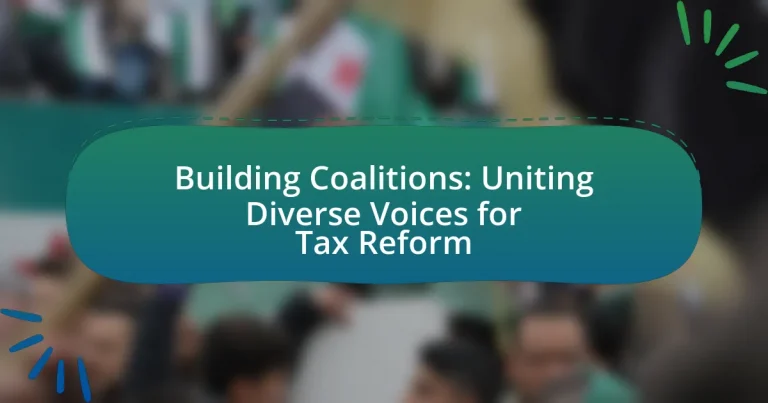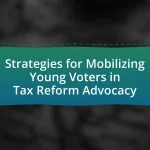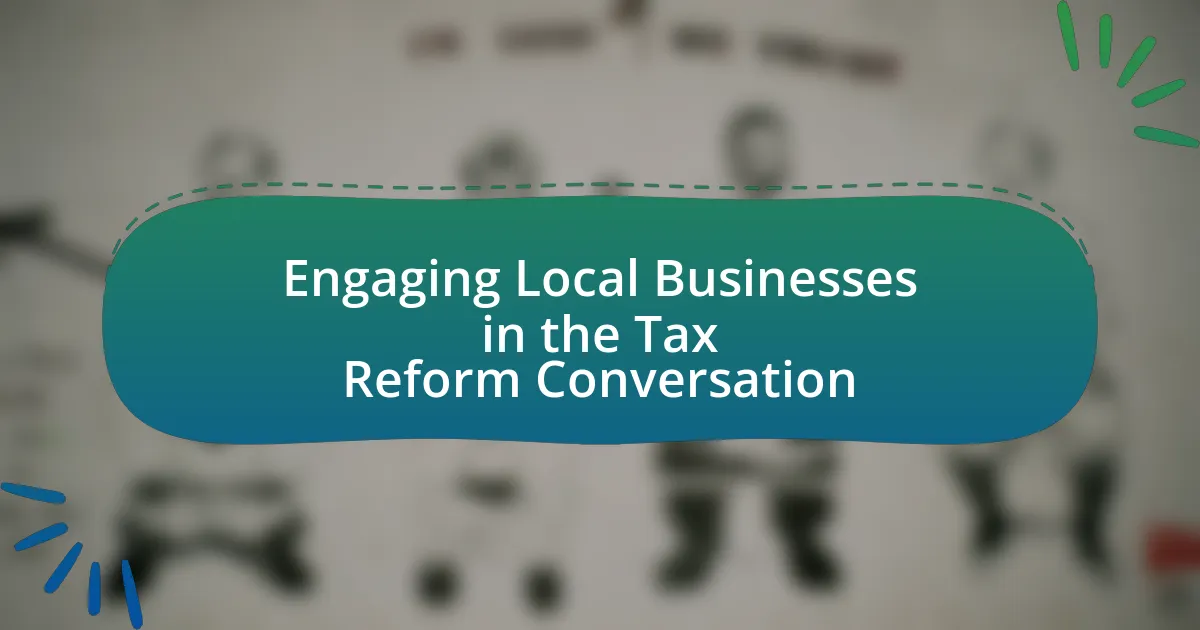The article focuses on the concept of building coalitions for tax reform, emphasizing the importance of uniting diverse stakeholders, including policymakers, advocacy groups, businesses, and citizens, to advocate for effective tax policy changes. It outlines the significance of incorporating varied perspectives to ensure equitable outcomes and discusses the challenges faced in aligning differing interests. Key components of successful coalitions, such as shared goals, effective communication, and strong leadership, are highlighted, along with strategies for mobilizing public support and navigating opposition. The article also examines the role of technology in enhancing coalition-building efforts and provides insights into measuring effectiveness and learning from past experiences in tax reform initiatives.
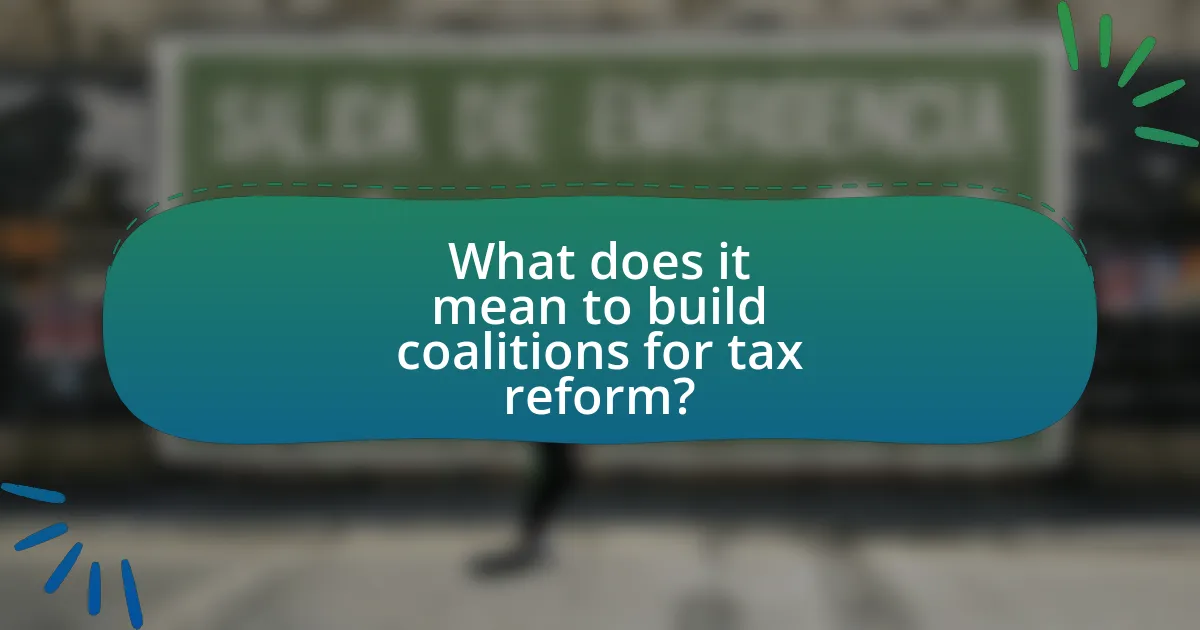
What does it mean to build coalitions for tax reform?
Building coalitions for tax reform means creating alliances among various stakeholders, including policymakers, advocacy groups, businesses, and citizens, to collectively support and promote changes in tax policy. This collaborative approach is essential because it brings together diverse perspectives and resources, enhancing the likelihood of successful reform initiatives. For instance, historical examples like the Tax Reform Act of 1986 demonstrate how bipartisan coalitions can effectively navigate complex legislative processes, leading to significant tax policy changes that reflect a broad consensus.
Why are diverse voices important in tax reform coalitions?
Diverse voices are important in tax reform coalitions because they ensure that a wide range of perspectives and experiences are represented, leading to more equitable and effective policy outcomes. When individuals from various socioeconomic backgrounds, ethnicities, and professions contribute to the discussion, the coalition can identify and address the unique tax burdens faced by different groups. Research indicates that inclusive coalitions are more likely to create comprehensive reforms that consider the needs of all stakeholders, ultimately resulting in policies that promote fairness and economic justice. For instance, studies have shown that tax policies developed with input from diverse communities tend to reduce disparities and enhance public trust in the tax system.
How do diverse perspectives enhance the tax reform dialogue?
Diverse perspectives enhance the tax reform dialogue by introducing a variety of viewpoints that reflect the needs and experiences of different stakeholders. This inclusion fosters comprehensive discussions that can identify potential impacts on various demographic groups, leading to more equitable and effective tax policies. For instance, research by the Institute on Taxation and Economic Policy shows that tax reforms informed by diverse voices can better address issues of income inequality and social justice, ultimately resulting in policies that are more widely accepted and supported by the public.
What challenges arise from uniting diverse voices in tax reform?
Uniting diverse voices in tax reform presents challenges such as conflicting interests, varying levels of expertise, and differing priorities among stakeholders. These challenges arise because different groups, such as businesses, low-income individuals, and public sector representatives, often have opposing views on tax policies. For instance, businesses may advocate for lower corporate taxes to stimulate growth, while social equity advocates may push for higher taxes on the wealthy to fund social programs. Additionally, the complexity of tax systems can lead to misunderstandings and miscommunication among stakeholders, further complicating consensus-building efforts. Historical examples, such as the 1986 Tax Reform Act in the United States, illustrate how diverse interests can lead to prolonged negotiations and compromises that may not fully satisfy any party involved.
What are the key components of successful coalitions for tax reform?
Successful coalitions for tax reform are built on key components such as shared goals, diverse stakeholder engagement, effective communication, and strong leadership. Shared goals ensure that all coalition members are aligned on the desired outcomes of the tax reform, which fosters unity and purpose. Diverse stakeholder engagement brings together various perspectives, including business leaders, community organizations, and policymakers, enhancing the coalition’s credibility and reach. Effective communication is crucial for articulating the coalition’s message and mobilizing support, while strong leadership provides direction and motivates members to work collaboratively towards the reform objectives. These components have been evidenced in successful tax reform initiatives, such as the 2017 Tax Cuts and Jobs Act in the United States, where a coalition of business groups and political leaders effectively advocated for significant changes in tax policy.
What roles do stakeholders play in tax reform coalitions?
Stakeholders in tax reform coalitions play critical roles as advocates, influencers, and facilitators of dialogue among diverse groups. They represent various interests, including businesses, non-profits, and community organizations, ensuring that multiple perspectives are considered in the reform process. For example, business stakeholders may advocate for lower corporate taxes to stimulate investment, while non-profit organizations might push for equitable tax policies that address social inequalities. Their involvement is essential for building consensus and fostering collaboration, which can lead to more comprehensive and effective tax reforms. Research indicates that successful coalitions often include a wide range of stakeholders, as their collective input can enhance the legitimacy and acceptance of proposed reforms.
How can effective communication strategies strengthen coalitions?
Effective communication strategies strengthen coalitions by fostering trust, clarity, and collaboration among diverse stakeholders. When coalition members engage in transparent dialogue, they can articulate shared goals and values, which enhances mutual understanding and commitment. For instance, research by the National Coalition for Dialogue & Deliberation highlights that effective communication practices, such as active listening and inclusive participation, lead to more cohesive and resilient coalitions. This is evidenced by successful tax reform initiatives that utilized structured communication frameworks to align various interests, demonstrating that clear and consistent messaging is crucial for coalition effectiveness.
What strategies can be employed to build effective coalitions?
To build effective coalitions, stakeholders should employ strategies such as establishing common goals, fostering open communication, and ensuring inclusive participation. Establishing common goals aligns diverse interests and creates a unified vision, which is essential for collaboration. Fostering open communication facilitates transparency and trust among coalition members, allowing for the sharing of ideas and concerns. Ensuring inclusive participation invites a variety of perspectives, enhancing the coalition’s strength and adaptability. Research indicates that coalitions with clear objectives and strong communication frameworks are more likely to achieve their goals, as evidenced by successful tax reform initiatives that brought together various interest groups to advocate for shared outcomes.
How can coalition leaders foster collaboration among diverse groups?
Coalition leaders can foster collaboration among diverse groups by establishing clear communication channels and shared goals. Effective communication ensures that all voices are heard and valued, which is crucial in a coalition with varied perspectives. Research indicates that coalitions with defined objectives and regular updates experience higher levels of engagement and cooperation among members. For instance, a study by the National Council of Nonprofits found that organizations that prioritize inclusive dialogue and collaborative decision-making report increased trust and commitment among participants. By promoting transparency and inclusivity, coalition leaders can create an environment conducive to collaboration, ultimately enhancing the coalition’s effectiveness in advocating for tax reform.
What methods can be used to identify common goals in tax reform?
Methods to identify common goals in tax reform include stakeholder consultations, surveys, and collaborative workshops. Stakeholder consultations involve engaging various groups such as businesses, non-profits, and community organizations to gather diverse perspectives on tax issues. Surveys can quantitatively assess public opinion and priorities regarding tax reform, providing data on what goals resonate most with the population. Collaborative workshops facilitate dialogue among stakeholders, allowing for the exploration of shared interests and the development of consensus on key objectives. These methods are effective as they leverage the insights and experiences of a broad range of participants, ensuring that the identified goals reflect a comprehensive understanding of the community’s needs and aspirations.
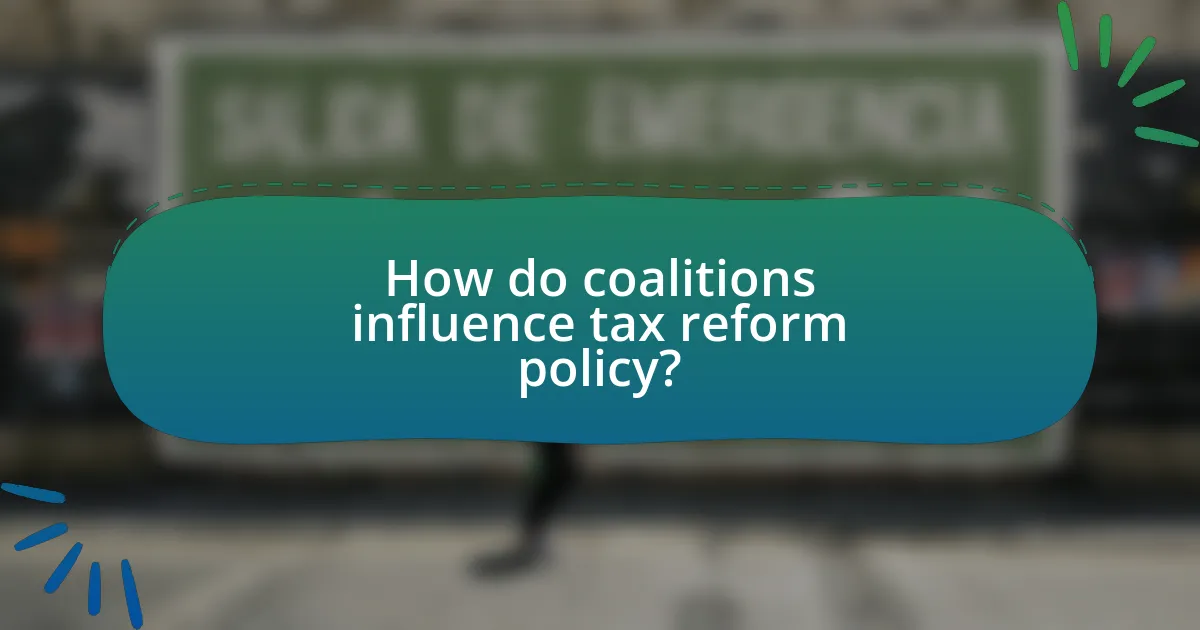
How do coalitions influence tax reform policy?
Coalitions influence tax reform policy by uniting diverse stakeholders to advocate for specific changes, thereby amplifying their collective voice and increasing political leverage. These coalitions often consist of interest groups, businesses, and community organizations that share common goals regarding tax policy. For instance, the coalition of business associations and labor unions can effectively lobby for tax reforms that promote economic growth and job creation, as seen in the 2017 Tax Cuts and Jobs Act, where various coalitions played a significant role in shaping the final legislation. By pooling resources and expertise, coalitions can mobilize public support, engage in strategic communication, and exert pressure on policymakers, ultimately impacting the direction and outcomes of tax reform initiatives.
What impact do coalitions have on legislative processes?
Coalitions significantly enhance legislative processes by uniting diverse interests to achieve common goals. They facilitate negotiation and compromise among various stakeholders, which can lead to more comprehensive and inclusive policy outcomes. For instance, coalitions often bring together different political parties, advocacy groups, and community organizations, allowing for a broader representation of perspectives and needs. This collaborative approach can increase the likelihood of passing legislation, as seen in successful tax reform efforts where coalitions have mobilized support across party lines, demonstrating that collective action can effectively influence legislative agendas and outcomes.
How can coalitions mobilize public support for tax reform?
Coalitions can mobilize public support for tax reform by leveraging collective influence and diverse stakeholder engagement. By uniting various interest groups, such as businesses, community organizations, and advocacy groups, coalitions can create a broader narrative that resonates with the public. For instance, research shows that coalitions that effectively communicate the benefits of tax reform, such as increased funding for public services or economic growth, can significantly enhance public awareness and support. Additionally, utilizing social media campaigns and grassroots organizing allows coalitions to reach a wider audience, fostering community involvement and encouraging public discourse around tax reform issues.
What examples exist of successful coalition-driven tax reforms?
Successful coalition-driven tax reforms include the 2012 tax reform in Colombia, which was achieved through a coalition of government, business leaders, and civil society organizations. This reform aimed to increase tax revenue and improve equity in the tax system, resulting in a significant increase in tax collection by approximately 1.5% of GDP. Another example is the 2017 tax reform in Canada, where a coalition of provincial governments and the federal government worked together to implement a carbon tax, which aimed to reduce greenhouse gas emissions while generating revenue for public investments. This reform has been effective in reducing emissions and has garnered support from various stakeholders, demonstrating the power of coalition-building in tax reform initiatives.
How do coalitions navigate opposition to tax reform?
Coalitions navigate opposition to tax reform by employing strategic communication, building broad-based support, and engaging in negotiation. Strategic communication involves clearly articulating the benefits of tax reform to various stakeholders, addressing their concerns, and countering misinformation. Building broad-based support includes forming alliances with diverse groups, such as business organizations, labor unions, and community leaders, to create a unified front that amplifies their message. Engaging in negotiation allows coalitions to make compromises and adjustments to the proposed reforms, thereby increasing the likelihood of acceptance among opposing factions. For instance, successful coalitions often highlight data showing that tax reforms can lead to economic growth, as evidenced by studies indicating that tax cuts can stimulate investment and job creation.
What strategies can coalitions use to address dissenting voices?
Coalitions can address dissenting voices by implementing inclusive dialogue, establishing clear communication channels, and fostering a culture of respect. Inclusive dialogue allows all members to express their concerns and perspectives, which can lead to a better understanding of differing viewpoints. Clear communication channels ensure that dissenting voices are heard and considered in decision-making processes, reducing feelings of alienation. Fostering a culture of respect encourages collaboration and minimizes conflict, as members feel valued and understood. Research indicates that coalitions that actively engage dissenting voices are more effective in achieving consensus and driving successful outcomes in initiatives like tax reform.
How can coalitions build resilience against political pushback?
Coalitions can build resilience against political pushback by fostering strong communication and collaboration among diverse stakeholders. Effective coalitions prioritize transparency and inclusivity, ensuring that all voices are heard and valued, which strengthens their collective position. Research indicates that coalitions with diverse representation are more adaptable and better equipped to respond to challenges, as seen in the successful advocacy efforts of the Fair Tax Coalition, which united various interest groups to effectively counteract legislative opposition. By leveraging shared goals and resources, coalitions can create a unified front that is more resilient to political challenges.
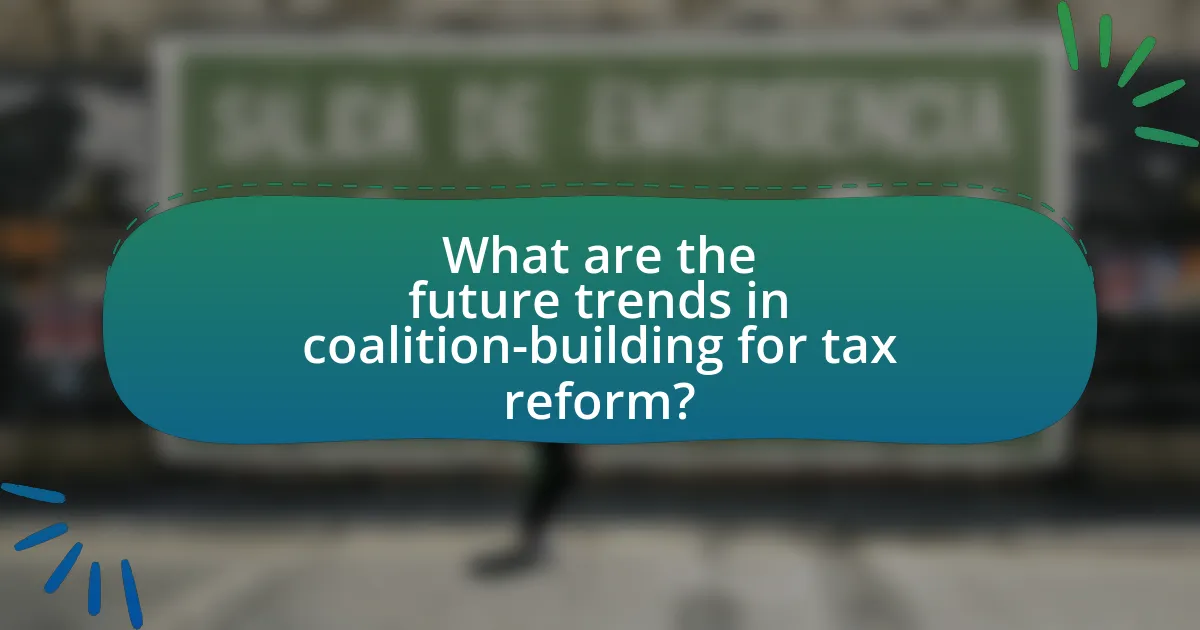
What are the future trends in coalition-building for tax reform?
Future trends in coalition-building for tax reform include increased collaboration among diverse stakeholders, such as businesses, advocacy groups, and policymakers, to address complex tax issues. This trend is driven by the recognition that comprehensive tax reform requires input from various sectors to create equitable and effective solutions. For instance, the rise of digital platforms facilitates real-time communication and coordination among coalition members, enhancing their ability to mobilize support and share resources. Additionally, data-driven approaches are becoming more prevalent, allowing coalitions to leverage analytics to identify key issues and tailor their strategies accordingly. These trends reflect a shift towards more inclusive and strategic coalition-building efforts aimed at achieving sustainable tax reform.
How is technology shaping coalition-building efforts?
Technology is significantly shaping coalition-building efforts by facilitating communication, collaboration, and mobilization among diverse groups. Digital platforms enable organizations to connect with a broader audience, share resources, and coordinate actions in real-time, which enhances the effectiveness of coalition strategies. For instance, social media tools allow for rapid dissemination of information and engagement, as seen in movements like the Women’s March, where online platforms played a crucial role in organizing participants across various demographics. Additionally, data analytics tools help coalitions identify key stakeholders and tailor their messaging, increasing the likelihood of successful advocacy for tax reform initiatives.
What digital tools can enhance collaboration among coalition members?
Digital tools that can enhance collaboration among coalition members include project management software, communication platforms, and document sharing services. Tools like Trello or Asana facilitate task assignment and tracking, ensuring that all members are aligned on project goals and deadlines. Communication platforms such as Slack or Microsoft Teams enable real-time discussions and information sharing, fostering a collaborative environment. Additionally, cloud-based document sharing services like Google Drive or Dropbox allow coalition members to access and edit documents simultaneously, promoting transparency and collective input. These tools collectively improve coordination, streamline workflows, and enhance overall collaboration among coalition members.
How can social media be leveraged for tax reform advocacy?
Social media can be leveraged for tax reform advocacy by facilitating communication, mobilizing supporters, and amplifying diverse voices. Platforms like Twitter and Facebook enable advocates to share information, engage with the public, and create awareness about tax issues. For instance, campaigns that use hashtags can unify discussions and draw attention to specific reform proposals, as seen in the #TaxReformNow movement, which successfully gathered support from various stakeholders. Additionally, social media allows for real-time feedback and interaction, enabling advocates to adjust their strategies based on public sentiment and foster a sense of community among supporters.
What best practices should coalitions follow for sustained impact?
Coalitions should prioritize clear communication and shared goals to achieve sustained impact. Establishing a common vision ensures that all members are aligned and working towards the same objectives, which enhances collaboration and effectiveness. Regularly assessing progress and adapting strategies based on feedback fosters resilience and responsiveness to changing circumstances. Research indicates that coalitions with strong leadership and defined roles experience greater success in maintaining momentum and achieving long-term outcomes. For instance, the National Network of Partnership Schools found that effective communication and shared leadership significantly improved coalition performance in educational reform initiatives.
How can coalitions measure their effectiveness in tax reform efforts?
Coalitions can measure their effectiveness in tax reform efforts by analyzing specific metrics such as policy outcomes, stakeholder engagement, and public support. For instance, successful coalitions often track changes in tax legislation that align with their goals, assessing whether proposed reforms are enacted and implemented. Additionally, coalitions can evaluate the level of participation from diverse stakeholders, including community organizations and businesses, to gauge their influence and reach. Surveys and polls can provide quantitative data on public opinion regarding tax reforms, indicating the coalition’s ability to shape discourse and mobilize support. Historical examples, such as the coalition efforts behind the Tax Cuts and Jobs Act of 2017, demonstrate how organized advocacy can lead to significant legislative changes, reinforcing the importance of these measurement strategies.
What lessons can be learned from past coalition experiences?
Lessons learned from past coalition experiences include the importance of clear communication, shared goals, and mutual respect among diverse stakeholders. Effective coalitions, such as the 2017 Tax Cuts and Jobs Act coalition in the United States, demonstrated that aligning objectives and maintaining open dialogue can enhance collaboration and drive successful outcomes. Additionally, historical examples, like the coalition formed for the Affordable Care Act, highlight that addressing conflicts early and fostering inclusivity can strengthen partnerships and lead to more sustainable reforms. These experiences underscore that successful coalitions require strategic planning, adaptability, and a commitment to collective action.
What practical steps can individuals take to support tax reform coalitions?
Individuals can support tax reform coalitions by actively participating in advocacy efforts, such as attending meetings, signing petitions, and engaging in community discussions. These actions help amplify the coalition’s message and demonstrate public support for reform initiatives. Additionally, individuals can contribute by sharing information on social media platforms to raise awareness and mobilize others, as studies show that grassroots campaigns can significantly influence policy changes. Engaging with local representatives to express support for specific tax reform proposals further strengthens the coalition’s efforts, as direct communication with policymakers can lead to increased attention on reform issues.
